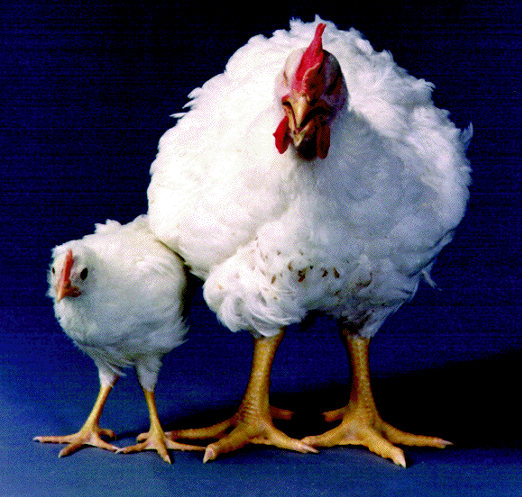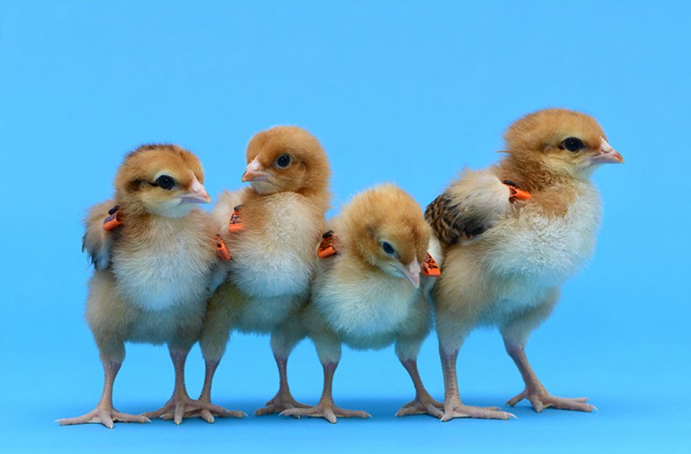Behaviour, physiology and welfare of commercially relevant poultry breeds
Physiological and neuroendocrine control of avian reproduction and growth, and improving welfare of commercially relevant poultry breeds.

Physiological & neural regulation of appetite
Roslin scientists have used an advanced intercross between a broiler (rapidly growing and raised for meat) and layer chicken, to investigate the genetic, neural and physiological basis of growth1,2, body fat distribution3 and appetite4–7. In addition, how the brain controls voluntary anorexia during incubation has been studied5. Future research will investigate how appetite is regulated during early life and the importance of early life stress. This research not only provides valuable information for industrial stakeholders in relation to the management of commercially relevant poultry breeds but can also deliver insights that can improve the welfare of poultry raised for meat or eggs.

Biobanking of poultry breeds
Our ability to cryopreserve avian species has been limited in the past. Recent developments in the culture and maintenance of primordial germ cells in vitro8 (stem cells that have the capacity to give rise to sperm or eggs), and the production of sterile surrogate hosts provides the opportunity to cryopreserve poultry breeds9. This protects against genetic bottlenecks or disease outbreaks that could threaten populations essential for food security or research. McGrew and colleagues have recently been awarded a grant by NC3Rs to validate the development of biobanks for flocks of poultry used for research purposes, which will limit the number of animals maintained and bred for research. The method could also be used to preserve rare chicken breeds. This research will help the preservation of endangered breeds of poultry, increase food security and reduce the number of animals used in research.
Publications
- Podisi, B. K., Knott, S. A., Burt, D. W. & Hocking, P. M. Comparative analysis of quantitative trait loci for body weight, growth rate and growth curve parameters from 3 to 72 weeks of age in female chickens of a broiler-layer cross. BMC Genet. 14, (2013).
- Podisi, B. K. et al. Overlap of quantitative trait loci for early growth rate, and for body weight and age at onset of sexual maturity in chickens. Reproduction 141, 381–389 (2011).
- Ikeobi, C. O. N. et al. Quantitative trait loci affecting fatness in the chicken. Anim. Genet. 33, 428–435 (2002).
- Dunn, I. C. et al. Decreased expression of the satiety signal receptor CCKAR is responsible for increased growth and body weight during the domestication of chickens. Am. J. Physiol. Endocrinol. Metab. 304, 909–921 (2013).
- Dunn, I. C. et al. Hypothalamic agouti-related protein expression is affected by both acute and chronic experience of food restriction and re-feeding in chickens. J. Neuroendocrinol. 25, 920–928 (2013).
- Reid, A. M. A. & Dunn, I. C. Gastrointestinal distribution of chicken gastrin-cholecystokinin family transcript expression and response to short-term nutritive state. Gen. Comp. Endocrinol. 255, 64–70 (2018).
- Caughey, S. D. et al. Sex differences in basal hypothalamic anorectic and orexigenic gene expression and the effect of quantitative and qualitative food restriction. Biol. Sex Differ. 9, 20 (2018).
- Whyte, J. et al. FGF, insulin, and SMAD signaling cooperate for avian primordial germ cell self-renewal. Stem Cell Reports 5, 1171–1182 (2015).
- Woodcock, M. E. et al. Reviving rare chicken breeds using genetically engineered sterility in surrogate host birds. Proc. Natl. Acad. Sci. U. S. A. 116, 20930–20937 (2019).


